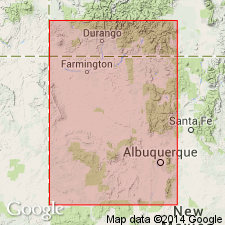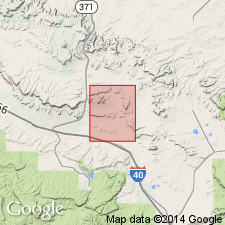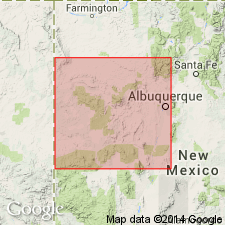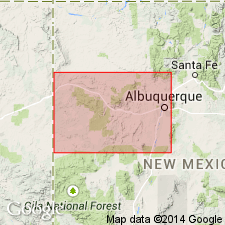
- Usage in publication:
-
- Whitewater Arroyo Shale Member
- Modifications:
-
- Named
- Dominant lithology:
-
- Shale
- AAPG geologic province:
-
- San Juan basin
Summary:
Named as a member of the Dakota Sandstone for exposures at type section which was measured across cuesta on north side of Whitewater Arroyo, NE1/4 sec 12, T12N, R19W, McKinley Co, NM in the San Juan basin. Overlies an unnamed member of Dakota. Contact is sharp and flat. Underlies Twowells Sandstone Member of Dakota gradationally. Consists at type of olive-gray (fresh), gray-weathering, silty laminated shale. Marine fossils: GRYPHAEA and EXOGYRA. Is 80 ft thick at type; averages 60 ft thick in Gallup, NM area and southward. The shale beneath the Tres Hermanos Sandstone to the east is probably equivalent to the Whitewater Arroyo. Cretaceous age. Cross sections.
Source: GNU records (USGS DDS-6; Denver GNULEX).

- Usage in publication:
-
- Whitewater Arroyo Tongue*
- Modifications:
-
- Revised
- AAPG geologic province:
-
- San Juan basin
Summary:
Whitewater Arroyo Shale Member of Dakota Sandstone adopted and reassigned to Mancos Shale as the Whitewater Arroyo Tongue. Was found to be correlative with an informal unit in Mancos designated lower shale in unit C. Is underlain by lower part or units A and B of Mancos and overlain by Twowells Tongue of Dakota. Placement of Whitewater Arroyo in Mancos is in keeping with regional assignment of marine shale units to east that intertongue, in the San Juan basin of NM, with continental and marginal marine sandstone to west. Tongue consists of 90-110 ft of yellow-brown to brown-gray fossiliferous shale. Schematic stratigraphic diagram.
Source: GNU records (USGS DDS-6; Denver GNULEX).

- Usage in publication:
-
- Whitewater Arroyo Shale Tongue*
- Modifications:
-
- Contact revised
- AAPG geologic province:
-
- San Juan basin
Summary:
Is composed of soft slope-forming shale and siltstone containing bentonite layers and cone-in-cone limestone concretions. Present over much of west-central NM in San Juan basin. Lower contact revised in that Whitewater Arroyo overlies Paguate Sandstone Tongue (a new name) of Dakota Sandstone; underlies Twowells Sandstone Tongue of Dakota. Is a shallow-water marine shelf deposit of Hartland or Late Cretaceous age.
Source: GNU records (USGS DDS-6; Denver GNULEX).

- Usage in publication:
-
- Whitewater Arroyo Tongue*
- Modifications:
-
- Biostratigraphic dating
- AAPG geologic province:
-
- San Juan basin
- Orogrande basin
- Basin-and-Range province
Summary:
Is a tongue of Mancos Shale. Assigned a late Cenomanian (Late Cretaceous) age based on identification of the ammonite CALYCOCERAS (PROEUCALYCOCERAS) CANITAURINUM from localities in McKinley, Sandoval, and Valencia Cos, NM in San Juan basin; Catron Co, NM in Basin-and-Range province; and Socorro Co, NM in Orogrande basin. Fauna places unit in the lower upper Cenomanian DUNVEGANOCERAS PONDI zone. C.P. CANITAURINUM has a wider geographic distribution than D. PONDI and thus serves as a useful zonal index fossil for the interval over a broader area.
Source: GNU records (USGS DDS-6; Denver GNULEX).

- Usage in publication:
-
- Whitewater Arroyo Tongue*
- Modifications:
-
- Biostratigraphic dating
- Overview
- AAPG geologic province:
-
- San Juan basin
Summary:
Is member of the Mancos Shale in the San Juan basin in west-central NM. Overlies Paguate Tongue of Dakota Sandstone in Moreno Hill and Laguna areas; overlies main body of Dakota in Upper Nutria and Gallup areas. Underlies Twowells Tongue of Dakota. Molluscan fossils are diverse; 19 bivalve species, 2 gastropod species, and 8 ammonite species are known from the area. Ranges in age from late middle Cenomanian ammonite zone of PLESIACANTHOCERAS WYOMINGENSE into the early part of the early late Cenomanian zone of CALYCOCERAS CANITAURINUM (Late Cretaceous). Base and top vary in age locally. Figure 2 is stratigraphic nomenclature and correlation chart of middle Cenomanian to lower Coniacian rocks in west-central NM, spanning 20 ammonite zones.
Source: GNU records (USGS DDS-6; Denver GNULEX).
For more information, please contact Nancy Stamm, Geologic Names Committee Secretary.
Asterisk (*) indicates published by U.S. Geological Survey authors.
"No current usage" (†) implies that a name has been abandoned or has fallen into disuse. Former usage and, if known, replacement name given in parentheses ( ).
Slash (/) indicates name conflicts with nomenclatural guidelines (CSN, 1933; ACSN, 1961, 1970; NACSN, 1983, 2005, 2021). May be explained within brackets ([ ]).

